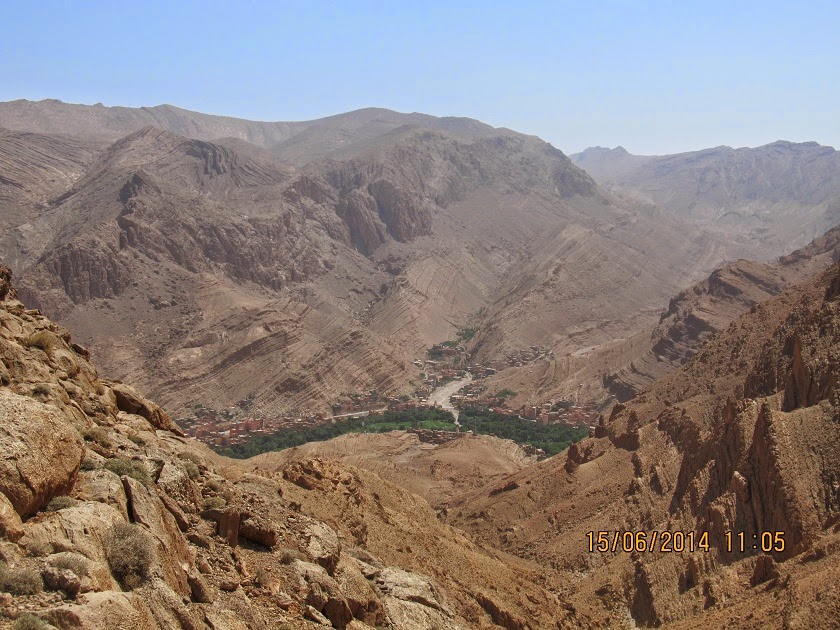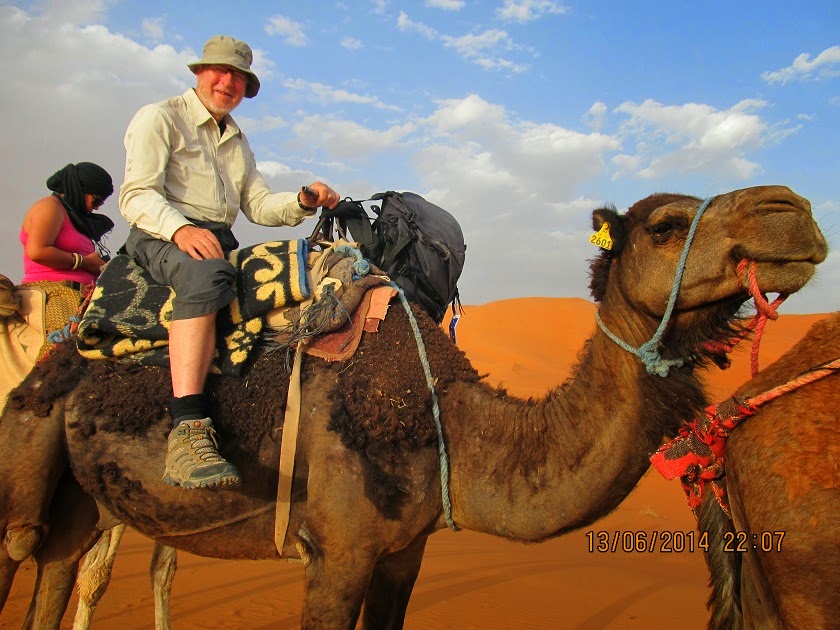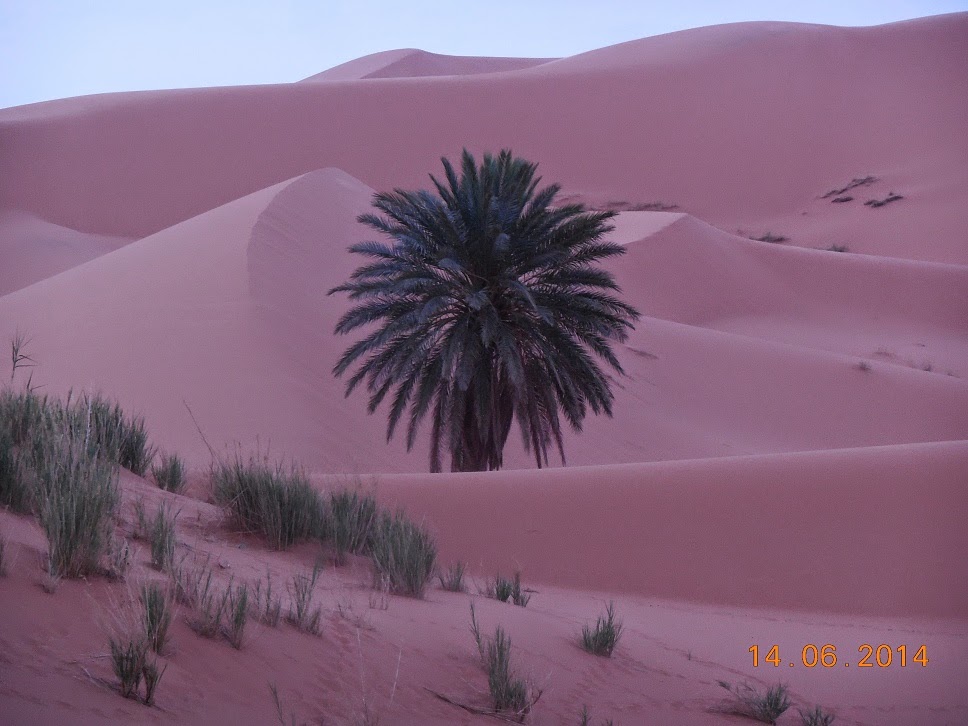We posted our first blog post from Morocco one week after
arriving here. During that week we stayed first at Tangier (near Gibraltar) and then
at Rabat, a two hour train trip down the Atlantic coast.
We then went to Casablanca, participated in a two-week
group tour, and are now
relaxing at a coastal city called Essaouira. Early next week we fly from
Marrakech to Lyon in France, pick up a lease car, and drive to Croatia. We plan
to stay in Eastern Europe for a couple of months before returning to mainstream
European countries and in December, it’s back to Australia!
Interestingly, the Camino phase of our adventure during which
we had ample time to reflect, has been overtaken by the pace of being tourists.
Fortunately, over the next months, we will again have time to periodically catch
our breaths.
We have experienced so much in Morocco that we've decided to spread the themes over several separate headings, so you can browse as you choose.
Group
travel
We undertook a fifteen day ‘Best of Morocco’ tour organised
through Intrepid Tours. Intrepid provide
tours aimed at experiencing life at a local level. Trip itinerary and notes can be accessed at http://www.intrepidtravel.com/morocco/best-morocco-70565
. For us, it was imperative to use an organised tour and we were delighted with it. Our
initial impressions of the country have expanded as we climbed mountains, confronted the millions of people in the city markets, rode
camels in the desert and relaxed at the seaside.
This was the first time we’d been on this kind of tour, so we were at first a little apprehensive. It turns out that of the ten participants, six were Australian, plus two each from USA and Canada. The small group size and genial group dynamic that developed was very good, and the tour leader was outstanding
In this post we describe and
illustrate the things that made memories for us.
Landscapes, agriculture and technology
Most of the country is extremely arid, with many areas of constantly blowing sand or bare rocks. The harshest regions support nomadic people with their herds of camels, goats and sheep. The occasional oasis is the only relief in those parts. Date palms are common in the few places where there is water.
Areas of better soils and rainfall are used for cereal crops, commonly harvested by hand (sickle or hand-plucking) into sheaves that are stacked together in stooks for later machine threshing. On the other hand, modern headers are also used. Ironically, where crops are really short and sparse it is not economic to use a header, so it's done by hand - perhaps hundreds of acres at a time. On really small plots, the use of hand labour makes more sense.
 |
| Sheaves of hay with grain, ready for threshing. Grain for domestic use |
Straw residues left after reaping are baled for use as fodder for donkeys, mules and horses. The hay is transported long distances to regional markets.
Morocco also grows olives, oranges and many vegetables. Melons are in abundance this month (June).
While semi-trailers and large trucks are on every major highway, the backbones of regional and village-level freight are those of animals. Another common mode of city freight movement is a sort of motor tricycle with a large tray. These vehicles are geared slower than a motorcycle, and power is transmitted through a differential.
Public transport is very good - buses, trains and minibuses.
 |
| Expansive areas of broad-acre cropping |
\
 |
| Broad-acre cropland harvested by hand. See the sparse sheaves? |
 |
| Elaborate haystacks |

|
Broad-acre cropland and olives
 Wind and water have worked on the landscape over centuries Wind and water have worked on the landscape over centuries


 |
There are also many miles of flat arid land
|
|
View from Morocco's highest mountain peak, with the road winding down below. Wherever you stop, someone is trying to sell you something!
 |
| A common sight |
 |
| Roadside village |
 |
| Donkey being used to |
 |
| Hand-made mudbricks |
Accommodation and food
On our tour, accommodation was mostly in unsophisticated hotels. Many seemed to be converted colonial mansions, or hotels that were in their heyday fifty years ago. All were in Moroccan style - colourful, heavy curtains and carpets, covering tiled walls and floors, and complete with Moroccan-style breakfasts of which we grew heartily tired - tasty and ample enough, but just the same menu day in day out ... a sort of fried flatbread, with runny jam, coffee, orange juice, and sometimes a boiled egg. No toast and vegemite anywhere! Nor fried eggs and bacon. In fact, bacon is unprocurable - seems they have something against pigs, full stop.
The lounge areas were always grand - lavishly covered benches arranged as a salon(?), with many heavily brocaded cushions. Fit for a sheik!
 |
| Hotel salon scenes |

 |
| We spent two nights here, allowing Bob and others to hike up the gorge |

 |
Our tour leader's family home
Couscous and tagines make up the main Moroccan cuisine, but although tasty, we've had enough of these for a while.
 |
| Berber omelette |
 Chicken tagine with olives and preserved lemon
Chicken tagine with olives and preserved lemon
 |
| Pastilla, which is either chicken or fish enclosed in a flaky pastry (nice) - but then topped with icing sugar and cinnamon which detracts from the overall taste |
On the more exotic side we thoroughly enjoyed our camel burgers.

One happy camel
 |
| It's all cooking at the Camel cafe |
 |
| Anne's camel burger |
Being an Islamic country, alcohol is not freely available apart from some hidden bottle shops or top tourist venues. Mint tea (widely known as Moroccan whiskey) is the drink of choice and we've had lots of that.
 |
| Making mint tea is done to a strict tradition and always served in small glasses, often with lots of sugar and poured from high above the glass. |
At the coast there is ample fresh fish, and a meal to remember was when our group went to the fish market and each bought some fresh seafood. This was then scaled and gutted nearby, and then grilled at a nearby restaurant. Combining it all gave us a sumptuous feast of delicious seafood - and a messy table.
 
Street food, sold from tiny shops and often cooked outdoors, smells delicious and we've had some of this, but have exercised caution as we have no desire for tummy bugs. We've also drunk only bottled water. The markets contain the extra bits that were now accustomed to seeing....e.g. the legs, heads, entrails and testicles of various animals.

Here at Essaouira, where we have our own apartment for a week, we bought a live chicken from a medina shop. The vendor killed, plucked and gutted it for us while we waited.
We've come to realize just how diverse a range of food one can get in Australia, something that just isn't possible in the countries we've been so far. We’re really keen to again taste Indian, Chinese, Thai or even just an Aussie barbecue again!
|
The Sahara
While a camel ride sounds just like a typical tourist activity,
we were both amazed by the experience. After a long drive through country that
became increasingly arid we arrived at the edge of the Sahara, at a point where
there are a number of hotel accommodation options. Not for us though; instead we
mounted our camels for an hour and half ride over the dunes to the
tent camp. To be on one of these animals
as they go quietly but steadily go over the dunes; to see your shadow outlined
on the sand; to sleep under the stars and sense the desert silence and
to know that if you wandered off there would be no way of knowing how to get
back....all link one with time
immemorial. Best of all though was to
watch the sun rise as a golden ball as it brings the desert landscape to light
....an experience that reaffirmed to me that there is a God and one who is so much
greater than I can ever understand.
We were fortunate in the timing of our visit for we heard
that, owing to desert winds and sandstorms, later groups had to have this part
of their trip cancelled
 |
| We were pleased that someone knew the way |
 |
The desert camp, but with it being a warm night we slept outside
|
 |
Camels in the pre dawn with the moon setting
And a few minutes later the sun rises on the opposite horizon (below) |

People and customs
Begging. Every tourist precinct (and also elsewhere), people with disabilities or other disadvantage sit and wait for alms, or actively seek it. Almsgiving is actually one of Islam's five pillars. In tourist areas, it seems that there are also professional beggars, some reputed to be quite wealthy.
Guides and trickery. A common trick is for the person to attach themselves to tourists who are studying their map, and well on their way to their hotel or other destination. The person enquires sociably about what country they are from, and where it is that they want to go, all very nice and chatty. They then indicate that they will show you the way and 'lead' you exactly where you were going anyway, then demanding money when you are there! We encountered this twice, once from an old man who ought to know better (after all, Allah wouldn't like it!), and once from a young boy and infant brother who accosted us in the manner described.
Rewarding children encourages school truancy and financial dependency, and also disturbs social equilibrium, in that a small child who becomes expert in this may well receive more income in a day than its father earns in a week of hard work in the dye pits!
A variation is where the person declares that 'No, the way you are going is wrong', but that he will gladly take you there. He then takes you on a devious long-way-round to your nearby hotel, again demanding money for the scenic route.
These tricks are all quite unfortunate, because there are also some people who really are just warm and helpful. Also regrettable, is that it teaches the tourist to avoid any social greeting or even eye contact, encouraging the locals to in turn regard us with disdain ...
 |
| Begging in the Medina (above - blind person with stick and hand outstretched) (below - bent-over lady begging) |
Another lady sitting and waiting for alms
 |
| An 'apprentice' in his father's café. He must be all of ten years old. The public education system is poor; many children choose not to go to school and up to 50% of the population is illiterate. |
 |
Apprentice guides who insisted on 'leading' us to the mosque where we were headed anyway, and then demanding money for the service
|
Hammam
If you're looking for a group bonding exercise for staff
professional development you may like to consider a hammam. This is the public bathing house used by
Moroccans (many of whom don't have running water or bathing facilities in their
house). Men and women have separate areas and strip down to their undies.
You then go into a heated room where you get buckets of warm water, wet your
skin, sit on the floor and apply a special soap all over your body (a soap made
from the residue of olive seeds and skin) and leave it absorb into your skin
for some minutes. Then the attendant
(dressed as you are) comes along with an abrasive bath mitt and scrubs you hard
all over. There is ample water for
rinsing and hair washing. A massage (or
stretching for men) can follow or you can sit on the warm floor and just
relax. For women, this is a real social
activity, and they will sit and chat with their young children playing
alongside. Anne loved the experience....Bob wasn't so keen, especially for the
stretching part. (There are no photos
included for this section!)
History
While European history was unfolding through the centuries - Phoenicians, Greeks, Romans, Kings, Generals, Bishops and Popes, North Africa too has had its share of all those, plus various dynasties and incursions. Relics of some of these have been found, starting with these Roman settlements at Volubilis near Fez:
 |
| I forget what this was about. Maybe something to amuse the ladies. (It's something the Romans left behind: see if you can work it out!) |
Then there are acres of ancient grain storage buildings, areas where thousands of horses were once stabled, morbid subterranean caverns where Christian sailors taken captive were held.
 |
| If these two scenes (above and below) look familiar its because they were used in movie settings, eg Lawrence of Arabia, Gladiator, Game of Thrones. Many local people are employed as extras when a movie is being made. |
 |
| Overlooking 200 acres of the Fez medina, built in the 14th century. The Medina is a world heritage listed site. |










































































